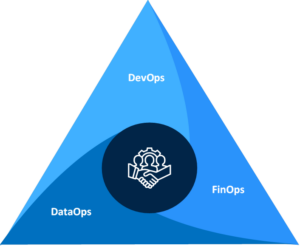The Winning xOps Trifecta
- December 8, 2022
Most believe DevOps is a team within an IT organization. In reality, however, it’s an operating model grounded in a culture or mindset inspired by Agile development. DevOps is defined as the marriage of development and IT operations to shorten development timelines, speed time to market, provide continuous feedback to software developers and improve quality. DevOps is a movement, still early in its lifecycle. More than 60% of organizations report being “mid-level” in their DevOps evolution according to Puppet’s 2021 State of DevOps report. Moving this needle requires investments in tooling and supporting IT, as well as buy-in of the cultural model and workflows.
DevOps began with the premise that a business operationally needs to become more agile, more technology-oriented and able to deliver technology with a solution or product focus – largely the delivery and management of infrastructure and applications. But the xOps soup has made this a bit messy.
DevOps organizations have the opportunity to accelerate the transition of IT from a cost center to a critical enabler of business strategies. After all, they’re able to take the vast amounts of data within an organization and make it easier for developers to write code and create killer apps or features. But DevOps has actually been so successful that it’s given rise to more “ops,” including FinOps, DataOps, AIOps, MLOps – or what we affectionately call the “xOps soup.”
 Each of these operational models is meant to help streamline development tasks and efficiencies, but they’re creating more complexity and workload responsibility for IT. IT Operations has had to embrace Agile development, while continuing their day-to-day of automating tasks, maintaining infrastructure and software layers, and providing support for developer tools, more often across multiple cloud operating systems. IDC says 96% of CIOs say their role is expanding beyond traditional IT responsibilities.
Each of these operational models is meant to help streamline development tasks and efficiencies, but they’re creating more complexity and workload responsibility for IT. IT Operations has had to embrace Agile development, while continuing their day-to-day of automating tasks, maintaining infrastructure and software layers, and providing support for developer tools, more often across multiple cloud operating systems. IDC says 96% of CIOs say their role is expanding beyond traditional IT responsibilities.
Then again, the engineer in me sees a potential solution: creating a tighter interlock across three core Ops functions: DevOps, DataOps and FinOps – the xOps trifecta.
There are different views of xOps, but I believe these three are the core drivers. Why? DevOps handles infrastructure and application deployment, as well as management agility. DataOps automates the process of collecting, securing, storing and distributing data throughout the organization. And FinOps operationalizes procurement, financing and oversight to manage IT and cloud spending throughout the organization. That’s the xOps trifecta.
In a multicloud scenario, FinOps uses cost management as a criterion to choose where to deploy or migrate infrastructure and applications to best serve business needs. This gives the engineering teams a business-certified ROI mechanism to deliver against. DataOps helps to determine where data should live and who should have access to it.
When combined and matured, DevOps, FinOps and DataOps will enable your business to function more efficiently and in an agile fashion, with immense payoff for AIOps. Further, the trifecta will support other Ops, like MLOps, to operationalize machine learning models and GitOps to drive continuous deployments. These functions will take advantage of the operating models instituted in the xOps trifecta.
But what about security? No company today can ignore the security of their assets, applications and tools. Because of this need, security needs to be integrated into every aspect of the company’s technical and operational functions. This means it cannot be segmented toward a DevSecOps view of the world, because both DataOps and FinOps have security needs that are vital to their success, such as DataOps securing data based on the governance mechanisms applied and FinOps requiring security for placement criteria used to determine the cost data. DevSecOps is only the beginning of the security journey in this xOps world.
Those on the path to becoming a mature DevOps organization should not ignore the need to operationalize their data and use business criteria to effectively manage costs. See the whole picture. Use your DevOps journey as a springboard to understand and unify the benefits of the trifecta built on a core of security. The end game is a culture where the convergence of DevOps, DataOps and FinOps enable IT Operations, using AI to automate core IT functions and enhance the capabilities of IT professionals. This will ensure your executives’ expectations meet operational reality.